 Prefer to listen to this piece?
Prefer to listen to this piece?
"What should I look for when shopping for a backhoe?"
Backhoe loaders are extremely versatile agricultural, industrial, and residential workplace machines with a wide range of capabilities. Backhoes loaders vary in size, function and condition. Knowing how to choose the right backhoe loader for your particular needs is crucial to ensure years of quality work.
What This Backhoe Buyer's Guide Covers
From cost-efficiency considerations to must-have attachments and other special features, this buyer’s guide will give you all of the insider information you need to make sure you’re purchasing the very best kind of
backhoe loader for your given industry and needs.
Table of Contents
- What is a Backhoe?
- What Backhoe specs to consider?
- How much does a Backhoe cost?
- What Backhoe attachments are available?
- Choosing the right model
- Backhoe tires, steering and stabilizers
- What Backhoe brand is the best?
- Inspecting a used Backhoe Loader
- Conclusion
"What is a backhoe?"
A backhoe loader, more commonly referred to as a backhoe, is essentially a tractor with a large front-mounted loader bucket that can carry up to 8,760 pounds on average. Backhoe loaders can push, level, or scoop lightweight materials as needed. The pieces of equipment are also outfitted with a second digging bucket on the rear that can dig an average depth of 15 feet with an average maximum reach of just under 26 feet.
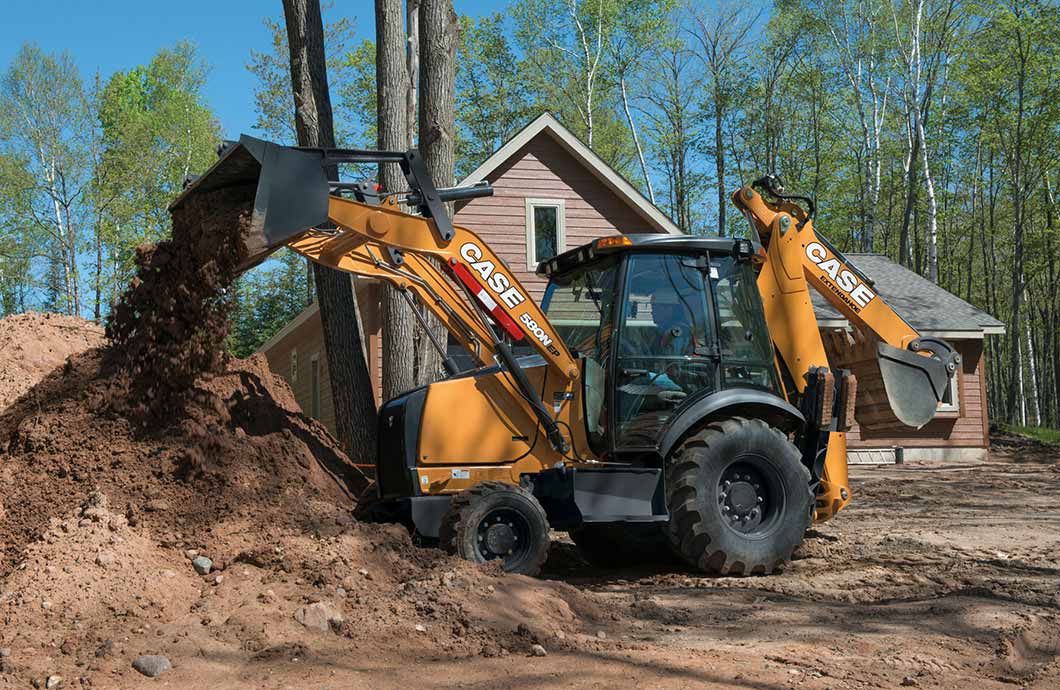
"What jobs are backhoes best used for?"
Backhoe loaders excel at medium-sized jobs. Unlike larger equipment, they are safe to drive on the road and don’t need to be transported for a variety of uses— cutting down on both project costs and delays. The valuable two-for-one design allows backhoe loaders to fulfill a wide variety of roles that can be further broken down into three main categories: agriculture, construction, and landscaping.
Agriculture
Whether you are laying irrigation pipes, burying livestock, or installing posts for your next barn site, there are plenty of reasons for farm workers to need to quickly dig a hole and fill it using a backhoe loader.
Construction
Whether for residential, commercial, or industrial use, backhoe loaders are immensely multifunctional pieces of equipment for construction crews. These machines are extremely useful for minor demolition work—allowing operators to demolish structures and then haul away the debris with the same piece of equipment. Backhoes are also great tools for moving earth during roadway construction—possessing the ability to dig as well as help grade.
Landscaping
Due to their diverse capabilities, backhoes serve a variety of functions in landscaping. Large backhoes are able to uproot entire trees as well as remove stubborn stumps. These machines are also ideal for constructing small to medium-sized artificial ponds—able to perform much of the excavation work while as well as performing other tasks, such as lining the spillway with rocks. Backhoes are also the ideal equipment for carefully stacking heavy rocks and carefully positioning stones for more advanced landscaping projects.
Additionally, backhoe loaders can be equipped with a variety of attachments to achieve other tasks such as mining and snow removal—which will be discussed later in this piece.
"What is a backhoe not good for?"
Smaller or Larger Projects
Although backhoe loaders are good for digging and moving quite large amounts of materials, even the largest backhoe loader is still on the small side as far as heavy equipment is concerned. As a general rule, backhoe loaders should not be used for larger jobs or for smaller jobs—whenever cheaper equipment like a mini-excavator or a skid steer can perform similar work.
However, when it comes to medium-sized jobs—especially on cramped job sites not accessible with larger equipment—a backhoe loader is usually the ideal piece of equipment.
"What backhoe specs should I consider?"
Due to their various capabilities, finding the right backhoe for your needs requires careful consideration of a variety of specifications.
Maximum Digging Depth
How deep do you need to dig? Small backhoe loaders typically dig between 7-10 feet, while the average full-size backhoe can usually dig at least 14 feet deep.
Rear Bucket Width
How big of a rear bucket do you need? Deciding how wide to make your rear bucket will have a major impact on your overall productivity. Smaller 12-inch-wide buckets have 2.5 cubic feet of space and can carry 250 pounds of material on average, while larger 60-inch-wide buckets can carry 20 cubic feet of material and support up to 670 pounds on average.
Loader Bucket Cutting Edge
Look closely at the leading edges, the width of bucket sides, and the integrity of bucket welds. Damage or inferior build quality in bucket side panels or the cutting edges may denote a bucket that will need to be replaced sooner rather than later.
Front Loader Bucket Width
A basic front bucket has no sharp corners for a smoother push. They tend to have a width between 89 to 96 inches. Such buckets can carry between 1-1.75 cubic yards of materials weighing anywhere from 1,590 to 2,100 pounds.
- Front-loaders can be outfitted with a multipurpose bucket for heavy-duty construction, demolition, and landscaping applications—such as tree removals. They usually have large clamping “jaws” that measure between 89 and 95 inches wide and can hold between 1.3 and 1.5 cubic yards of materials weighing anywhere from 1,590 to 2,100 pounds.
- Side Dump – Side dump variation backhoes are used for everything from loading and dumping to backfill operations. The bucket can be emptied straight forward or to the left, making it perfect for cramped conditions. This attachment can haul between 1 to 1.25 cubic yards of materials that weigh anywhere from 1,890 to 2,060 pounds.
Operating Weight
Do you want to have a minimal impact on the environment—such as working on a golf course, backyard, or cemetery? In this case, you'll want to choose a backhoe loader with a lighter operating weight. If you aren’t worried about leaving tracks behind—such as when performing agricultural jobs—then you can choose a backhoe with a heavier operating weight rating.
Horsepower
A backhoe loader that’s 14 to 15 feet long should have between 68 to 107 horsepower. Larger models should have at least 127 horsepower.
Condition of Drive Shaft
If you're test-driving a used backhoe for sale, it is important to listen for any irregular sounds coming from the driveshaft. Such rattling or other sounds may denote a damaged transmission or a bent or damaged drive shaft.
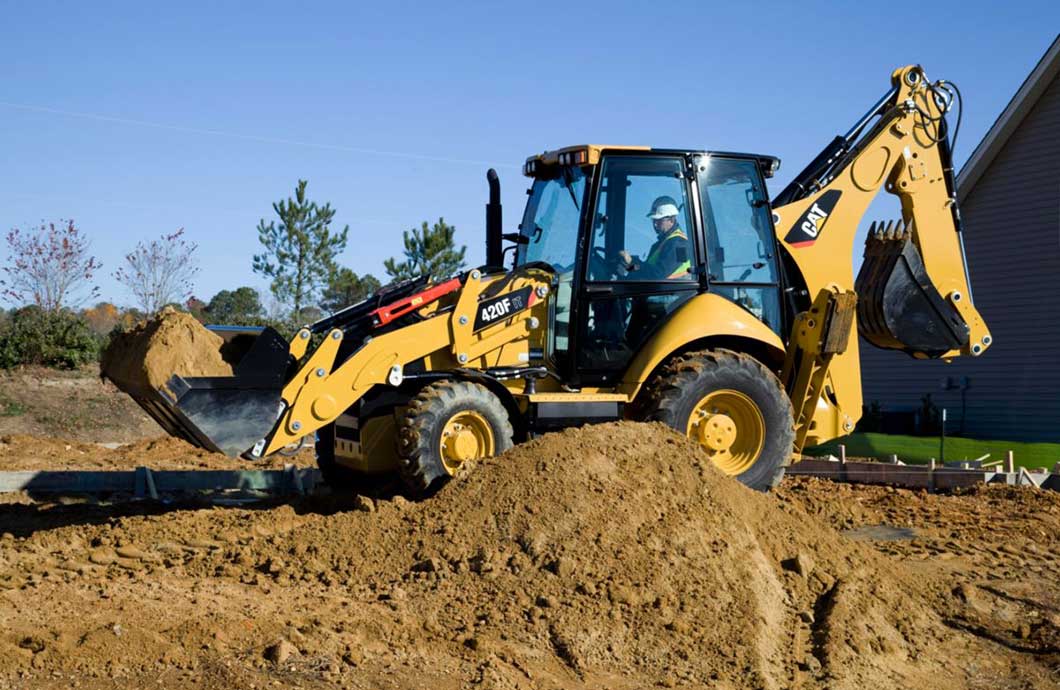
"How much does a backhoe cost?"
The average backhoe has a digging depth of 14 feet and between 80-90 horsepower. If you’re buying a new model of this variety, they can range anywhere from $55,000 to $75,000. With this in mind, you can choose to go up or down in price accordingly.
- Mini or Small Backhoes – Models that can dig between 9 and 10 feet typically cost $25,000 to $35,000.
- Large Backhoes – Models that can dig between 15 and 16 feet typically fetch $75,000 to $110,000.
- Larger Backhoes – Any model over 16 feet tends to cost well over $100,000.
The above prices are estimates of new backhoe prices. Used model backhoe prices tend to run significantly less. A 14-foot used Case backhoe for sale, for example, could cost anywhere from $25,000 to $44,000 (roughly the same price as a new compact backhoe), and 16-foot models are only $50,000 to $70,000 on average. Since a responsible owner can easily get 10 years out of a well-maintained backhoe, opting for a used model may be a smart move.
The Cost of Renting a Backhoe
If you are renting a backhoe, you can pay daily, weekly, or monthly rates. The average cost of renting a backhoe is between $200 and $500 per day. Otherwise, renting a backhoe typically costs between $600 to $1,500 per week, and anywhere from $2,000 to $3,000 per month. As you can see, renting a backhoe for just six days can cost the same as a month when paying daily rates. You can probably see why buying one is much cheaper for long-term use!
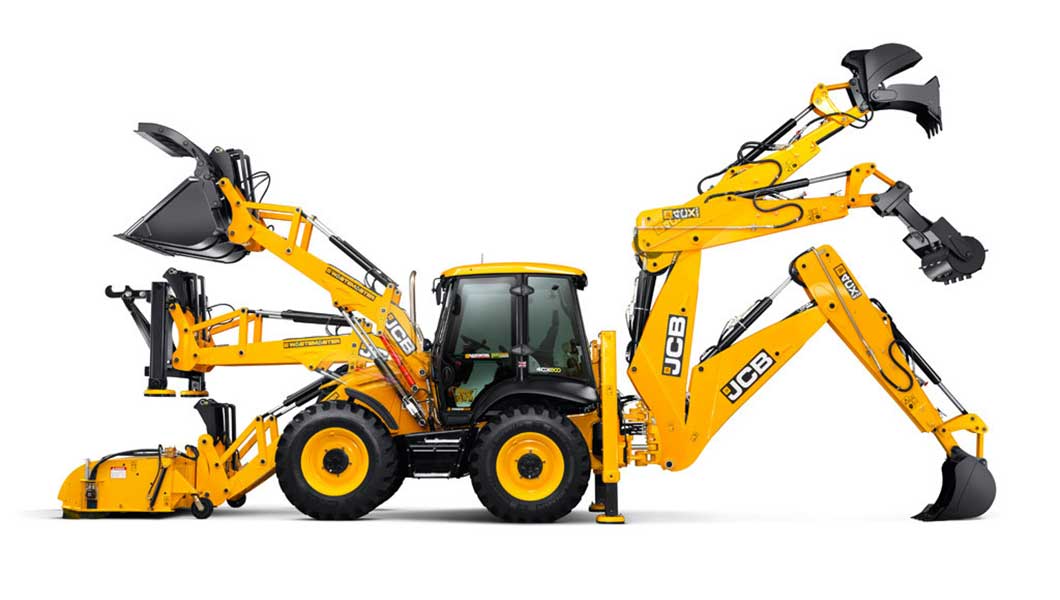
"What Backhoe attachments are available?"
Backhoe Attachment Capabilities & Costs
If you are going to be switching backhoe attachments frequently, then you might want to invest in a backhoe with a quick attach system—known also as “
quick couplers”. Aside from being a standard industry connection that will work with most attachments, most backhoes also include additional components that will allow you to hook directly into the hydraulic system for hydraulic-powered attachments—such as snow blades. A quick attach system will work with both rear and frontal attachments.
As for the attachments themselves, the following are some of the most popular:
- Fork Pallets – Keep your loads stable and transport pallets without the need of a forklift.
- Cost: between $650 and $830.
- Snow Blades – Powered by hydraulics and capable of withstanding the harshest winter conditions, this attachment comes in many variations to clear pathways through snow.
- Cost: between $1,600 and $2,900.
- Hammers – These devices attach to the rear so you can break down concrete, asphalt, and frozen soil (they can also use a silencer to dampen noise).
- Cost: between $2,900 and $4,000.
- Multipurpose Buckets – As the name implies, these buckets can handle extra-large objects and especially heavy materials. They are available in 4x1 and 6x1 sizes.
- Cost: between $1,400 and $1,800.
- High Tip Bucket – This bucket’s extra reach allows you to access areas with high clearance.
- Cost: between $2,700 and $4,500.
- Side Tip Bucket – Unloads from the side (for tight spaces such as corridors and tunnels), and also good for small-scale trenching jobs.
- Cost: between $1,500 and $4,500.
- Fixed Ditching Bucket – Cleans out ditches, backfills, and grades.
- Cost: between $600 and $1,200.
- Non-Fixed Ditching Bucket – Though more expensive than a fixed ditching bucket, this bucket can tilt in either direction to clean out ditches, backfill, and grade much more quickly.
- Cost: between $1,100 and $2,800.
- Bale Spike – Farmers can fix this attachment to the front and transport large bales of hay.
- Cost: between $220 and $280.
- Log Grapple – Specifically designed to rip down and haul full-grown trees anywhere from 1,300 pounds to over 26,000 pounds, and 30 to 122 inches wide, depending on the exact model.
- Cost: from $1,800 to over $5,000.
- Fork and Grapple – Similar to the log grapple, this attachment can stabilize and transport materials that cannot properly fit on a pallet.
- Cost: between $800 and $4,600.
- Grinders – Allows you to grind down stumps to a level surface. A double-heel rack can even grind below the surface to dig out the remaining root system if needed.
- Crushers – Can be used to crush everything from concrete and rocks to ore for mining applications.
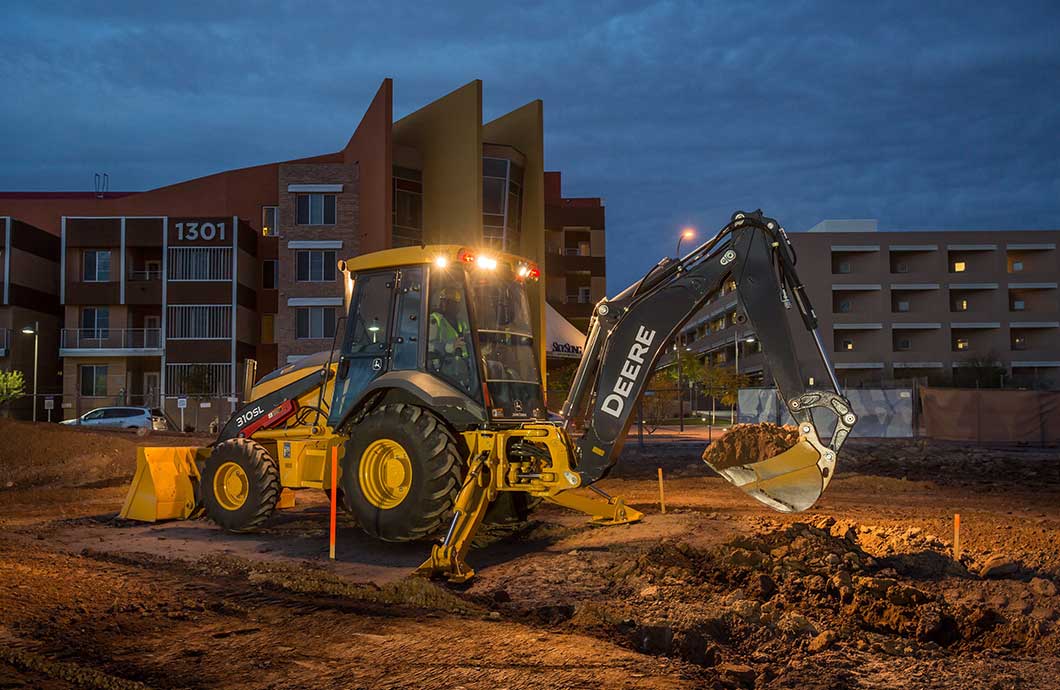
Designs: How to Choose the Right Backhoe Loader Model
Backhoe loaders can be split into two types: center-mount and side-shift.
Center Mount Backhoes
Also known as a “center pivot” backhoe, center mounts secure the backhoe in the center of the rear so that it can’t move. The stabilizers come down in a wider stance than side-shift backhoe loaders—providing additional height along with a stronger center of gravity. This wider stance gives center mount backhoes the stability advantage when working with heavy loads and steep terrain.
Side-Shift Backhoes
Instead of being fixed in the center, the side-shift backhoe can move from side to side and even extend vertically. Stabilizers extend straight down from the sides, which allows for tight maneuvering in confined spaces—even when other structures are nearby.
"Which backhoe design best suits my needs?"
Choosing between a center-mount or side-shift backhoe depends on the type of work you need to do. In general, a center mount backhoe is used for farming and wide-open construction jobs—not so much in landscaping or roadways. Conversely, side-shift backhoe loaders are primarily used for roadway and landscaping purposes.
There are some other pros and cons for each design as well. Center-mount backhoes are more prominent in the United States—a popularity tied to historical preference and a lower price. These prices can start as low as $42,000 for newer models—whereas prices for side-shift backhoe loaders begin at $55,000. Side-shift backhoes, on the other hand, are generally more precise, allowing crews to perform quickly and using less fuel.
Aside from these two designs, however, backhoes have been further split up into two unofficial divisions because manufacturers place such emphasis on digging depth and overall size.
- 14-to-15-foot backhoes – Manufacturers created this category for those who need a backhoe capable of performing medium-sized jobs without providing a deep footprint. Typically, backhoe loaders in this range have between 68 and 107 horsepower with a hydraulic system that puts out 28 to 35 gallons per minute. These models are typically used for landscaping, public utilities, small-scale construction, and agricultural purposes. JCB, Case, and John Deere all have backhoes designed for this category.
- Over 15 feet – With 127 horsepower and a hydraulic system that can put out upwards of 43 gallons per minute on average for an incredibly powerful lift, these models are designed for heavier industrial jobs such as demolition and mining.
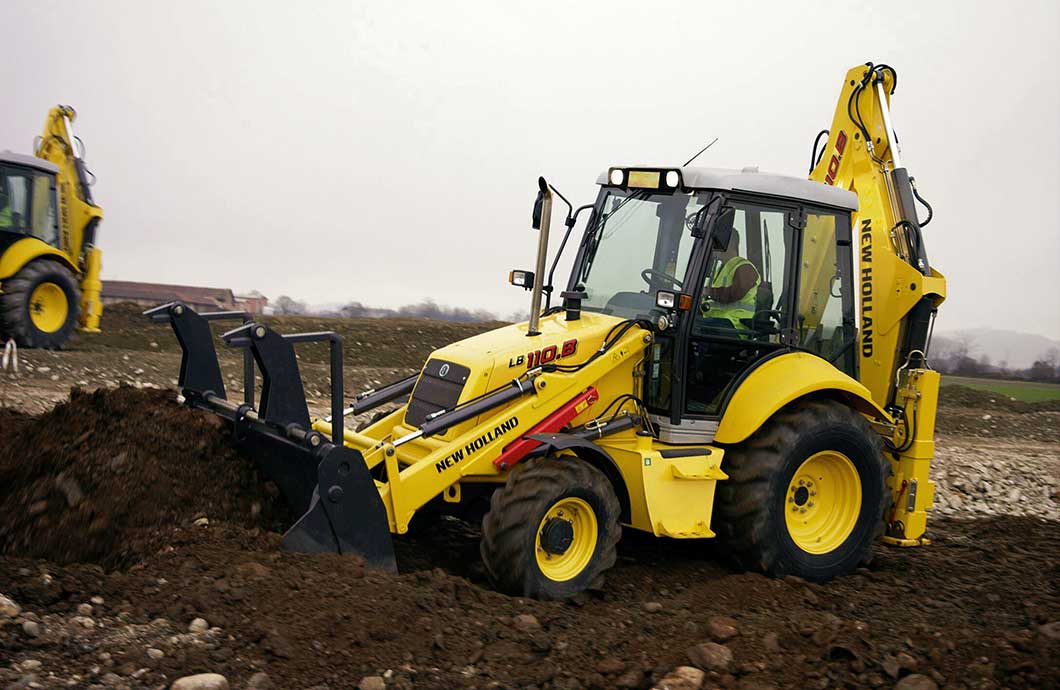
Backhoe Tires, Steering, and Stabilizers
No matter the workload for a backhoe, tires matter. The back tires are always bigger than the front tires to provide extra stability, but this isn’t enough. Air-filled backhoe tires, for example, are more susceptible to puncture than tires filled with foam. Also, radial tires usually have better traction—good if you are on loose or muddy ground—but they generally cost more than bias tires.
R1 Tires (Agricultural)
R1 tires are as tough as it gets—capable of withstanding extreme mud and other unfavorable conditions that you’d expect to find while hard at work on the farm.
R3 Tires (Turf)
R3 tires are commonly known as the landscaper’s tire. Unlike R1 tires, they are designed with an even weight distribution system that won’t leave imprints, even while on grass. However, this very same system makes them perform poorly under wet conditions. However, they are perfect for golf courses, yards, and cemeteries.
R4 Tires (Construction)
R4 tires are specifically designed to accommodate heavy loads on pavement. These backhoe loaders are best for residential and industrial construction projects.
Four-Wheel Drive (4WD) & Four-Wheel Steering Capabilities
Four-wheel drive (4WD) backhoe loaders are common in newer models and have the best traction for driving on muddy or loose earth. 4WD puts more wear and tear on the transmission but most backhoe loaders include it out of necessity. Four-wheel steering, on the other hand, is less common and more expensive. It provides additional maneuverability by moving all of the wheels together at once. The JCB 3CX Compact backhoe is said to have some of the best maneuvering capabilities on the market.
Types of Backhoe Stabilizer Legs
Backhoe loaders come with two stabilizer legs that swing down from the side and dig into the ground to prevent rollovers and lifting-induced tire blowouts. There are two different types of “shoes” on the bottom of the stabilizers, and you need to make sure that you match the right one with the right surface for maximum stability and minimum damage to sensitive terrain—such as pavement or grass.
- Rubber – Provides stability on asphalt while sparing the surface.
- Grouser – Provides stability on dirt.
"What backhoe brand is the best?"
Choosing between a
Case,
John Deere,
Cat,
JCB,
New Holland,
Bobcat, and all of the other brands can be tough—especially when every manufacturer claims their models are the superior choice. Here’s a quick rundown of some of the major manufacturers and where they fit in the industry.
JCB Backhoe
There's debate over when and who first came up with the concept of the backhoe loader. One of those claims goes to the UK-based Joseph Cyril Bamford—the founder of JCB, who created his version of the backhoe loader in 1953. Since then, JCB has been a leader in the backhoe market ever since with their 3C and 3CX lines. Today, six different models make up the 3CX line—from compact to very large and almost half of all backhoe loaders are made by JCB.
Case Backhoe
When it comes to backhoes, Case is one of the most prominent brand names. Their name recognition is likely due to the fact that they’ve been building a backhoe loader product line since 1957—all the while continuing to improve their versatility and performance despite encroachments by skid steers and mini excavators.
John Deere Backhoe
The John Deere backhoe is oftentimes a mix of power and cost-effective design. Many times, a John Deere backhoe will have a modest engine with an upgraded belt-drive fan to increase the horsepower without having to charge extra. For a reliable design with no thrills, a John Deere backhoe is a good choice—especially for larger models.
Caterpillar Backhoe
A "Cat" backhoe is very popular because many newer models have a load-sensing hydraulic system for more precise controls. Some of the entry-level models even have pilot-operated joystick controls instead of wobble sticks for more legroom.
New Holland Backhoe
New Holland backhoes tend to be more popular in the international market than in the United States. This brand has been making construction equipment for nearly 20 years. Many users say that that a compact New Holland backhoe is the best of the smaller models.
No matter which manufacturer you like best, you still have to do your research when buying a new or used model. Consumer reviews, company awards, and the terms of your maintenance agreement are all essential considerations. It's also important to research which companies have the fastest support centers with the shortest downtimes. Customer service is crucial for quickly resuming operations should anything happen to your backhoe.
How to Inspect a Used Backhoe Loader
Even if it is the latest John Deere backhoe and it’s only been used for a day, you should still closely examine any used backhoe loader to gauge wear and spot problematic damage.
Inspecting the Loader Bucket
Make sure the teeth of the loader bucket aren’t loose, missing, or worn. Double check that all the bolts are still in place. The cutting edge should not be scalloping and may need to be flipped if one side looks overly worn.
Inspecting the Loader Arms
Any backhoe loader arms should be free from any cracks or obvious re-welding jobs— which signify that the backhoe has either been overused or rolled over in an accident. Make sure to carefully examine the backhoe boom and stick as well.
Inspecting the Hydraulics
The hydraulics should be checked for breaks and scratches within the hoses. The couplings should not be worn or loose. Likewise, cylinders should not be leaking or otherwise damaged— including dings and scratches that may turn into leaks, leading to contamination of the hydraulic fluid with dirt and other foreign substances. When operating an attachment, you should not experience any difficulties steering and the pressure should remain stable.
Inspecting the Engine
The backhoe's engine should not have any leaks, loose belts or dirty filters. The air filter may or may not have a service date on it. If it does, then this information can be valuable in determining how responsible the previous owner was with routine maintenance. The stabilizers should not be leaking, cracked, dented, and the shoes should be flat. Make sure to turn the backhoe on first before checking.
Inspecting the Cab
When you’re inside the cab, make sure the seat, joysticks, and foot pedals are all in working order. Check the hour meter and compare it with the current condition of the cab. If the backhoe loader looks much older than the hour meter says, then this could be a sign of tampering—a major red flag for any buyer.
Conclusion
For years, people have claimed the backhoe would sooner be replaced by mini-excavators and skid steers. However, the backhoe is still very much viable today due to its versatility. A quality backhoe remains largely unmatched in terms of versatility, power, and maneuverability for medium-sized tasks.
Congrats—you're ready to start shopping for your next backhoe!
Armed with the knowledge of what to look for depending on your needs, you should be ready to shop for a quality backhoe loader that, with the right care, will faithfully serve you for many years to come.
You're invited view our wide range of new and used backhoes for sale and select the right backhoe for the job. Use filters to find your next backhoe in seconds!